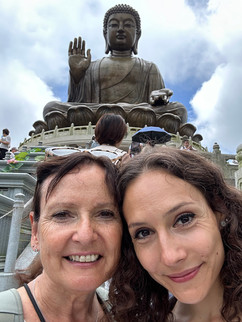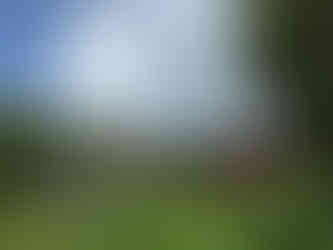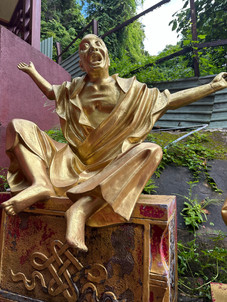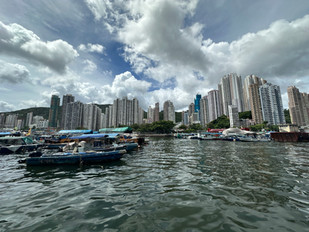Unmissable Wonders: Hong Kong's Must See-Places
- sinjahaag
- 9. Okt.
- 19 Min. Lesezeit
The first time I set foot in Hong Kong, I was struck by how different the city felt from what I initially expected it to be.
Sure, modern skyscrapers, a high density of people and tourism, underpinned by a blend of Cantonese-English tones, were immediately noticeable. Yet it was the city’s true diversity—ranging from social variety, cultural heritage, language, agricultural expressions, and traditional practices that left a deep impression on me. Hong Kong is far more than a modern, glass-covered high-rise district; it is a melting pot of cultural diversity that fascinates, inspires, and surprises through the richness of its people, land, and traditions.
In this post, I want to share with you the must-see places in Hong Kong that left me in awe, yet by far not covering everything I would have wanted to see in a matter of a week visiting.
Where this Guide will take you
Victoria Peak: Peak Tram, panoramic views & Sky Terrace 428
With over 552 meters in height, Victoria Peak, also known as "Mount Austin" or simply "the Peak", is the highest point on Hong Kong Island and consequently one of the most frequently visited places. From here, you will be able to enjoy marvellous views upon Hong Kong Island, Victoria Harbour, Kowloon- and further surrounding islands. Easily accessible hiking trails will additionally take you through some green overgrown paths with magnificient views. And getting here only takes you around eight minutes by taking one of the oldest, gravity-densifying, streetcars of Hong Kong: the Peak Tram.
Arriving at the top: skyviews, shopping and hiking opportunities
Once you arrive at the top, you'll directly bump into two shopping- and entertainment centres, namely Peak Tower & Peak Gallery. Inside the wok-like-appearing Peak Tower, Sky Terrace 428 reveals a breathtaking panoramic view onto Hong Kong's skyline. With 428 meters in height, Sky Terrace is the in fact the highest observatory deck you will find all over Hong Kong. An alternative panoramic view is offered inside Peak Galleria on the third floor. The advantage of this platform is that it is free of charge and- at least to my belief- just as worthy as Sky Terrace 428. Next to the free-of-charge panoramic platform, Sky Galleria offers plenty of further entertainment options, such as souvenir shops, restaurants or Madame Tussauds Hong Kong.
The "Peak Circle Walk" offers a relaxed 3,5km long trail with great photo spots whilst enjoying quietness and natural surroundings. A lot of people tend to come during dawn to see the city's skyline gloom at night, paired with a fairly pricy dinner at "the Peak Lookout" or some other dining options, such as Wildfire, Bubba Gump or Lu Feng.
Practical Information (Tram Peak)
Address: 33 Garden Rd., Central, Hong Kong
How to get there: take the MTR towards Central Station (Exit J2 or K), walk uphill along Garden Road to reach Peak Tram Lower (Central) Terminus.
Alternatively, take bus route 15 / X15: board at Exchange Square (Central MTR Exit A) or Central Pier 5/7 & ride directly to the entrance, or, take Green Mini Bus No. 1 from Hong Kong Station (Exit F Public Transport Interchange) towards Peak Galleria
Opening Hours: 7:30am - 11pm; departure every 15 - 20min.
Admission: HK$75, special ticket combos available; check the latest updates here
Tsim Sha Tsui Promenade & Avenue of Stars
Tsim Sha Tsui is a beautifully designed promenade offering unforgettable views of Hong Kong's skyline. The promenade begins parallel to Salisbury Rd west of Victoria Dockside and continues eastward to the Hong Kong Coliseum and Hung Hom Station.
It's a great place to stroll during the day, though at night the real spectacle begins—especially during the Symphony of Lights, when hundreds of people gather along the railings, on benches, in cafes, and restaurants to watch the spectacular sound and light show.
The Avenue of Stars, an integral part of the Tsim Sea Tsui East Promenade, was reopened in 2019 after extensive renovations and features sculptures, information boards, and handprints from the Hong Kong film industry, as well as a statue of Bruce Lee.
Practical Information
How to get there: take the Tsuen Wan Line (Red Line) towards Tsim Sha Tsui Station. Alternatively, you can take public buses running from Central/Hong Kong (CityBus, KMG bus), or the Star Ferry from Central, directly leading you to Tsim Sha Tsui
Symphony of Lights: iconic multimedia- and sound at night
On our second day in Hong Kong, I grabbed my mum by the arm and stated "let's go, mum, I have something really cool to show you!". So, off we went to one of Hong Kong's most popular nightly attractions to visit: the Symphony of Lights (SoL).
Hong Kong's Symphony of Lights is an iconic, every day repeating, multimedia light- and sound show representing the vibrant energy, charisma and melting pot culture of the city. It takes place every night from 8pm onwards (unless weather warnings appear) and lasts for approx. 10 minutes. Within this timeframe, a total of 43 buildings of the Hong Kong skyline transform into a coordinated interplay of lights, lasers, LED illuminations and firework displays, underlined by background music.
In fact, the musical background features play a significant role during the show, blending modern and classical elements into one to evoke an emotional composition by relying on a beautiful storyline that is based upon five main elements:
awakening (symbolising the genesis & growth of Hong Kong),
energy (symbolising Hong Kong's energy & strength),
heritage (symbolising Hong Kong's diverse culture and tradition),
partnership (symbolising the union of the two sides of the Harbour) and
celebration (symbolising the prosperous future of Hong Kong).
The Symphony of Lights has been an integral part of Hong Kong's attractions since 2004 and is recognised by Guiness World Records as the world's largest permanent light- and sound show. In 2017, a reorientation of the musical background was carried out under the motto "east meets west" to once more emphasise on the energetic & rich cultural diversity of the city.
The show can be viewed for free from both sides of Victoria Harbour. Since this show is a popular event, you might wanr to come early to save a best-possible viewing spot. Phenomenal viewing areas/points are e.g. Tsim Sha Tsui Promenade (along the Avenue of Stars), Golden Bauhinia Square (promeande in Wan Chai), central harbour front or skyscrapers allowing a panoramic view upon Hong Kong's skyline. Last but not least, you can book a ferry cruise to watch the nightly spectacle from the water whilst enjoying some snacks and drinks. Several providers offer different package options to choose from. I went for a traditional Chinese junk boat with large red deck sails and an antique looking exterior. The easiest way is to book your tickets in advance via klook, trip.com, GetYourGuide or Tripadvisor to comfortably be seated.
Is it worth booking a boat tour considering the show only lasting for 10 minutes? I'd say yes! Simply because of the fact that from the midst of water, you will have a great 360-degree view onto both sides of the harbour , enabled to track the sequence of lights from all angles. Plus, it's a fun and not overly expensive thing to do. How many times do you have the possibility to join the Symphony of Lights? So, get your ticket, hop on a boat, grab a drink and enjoy yourself with an afterwards relaxing water cruise whilst counting stars on on your way back to the dock.
Temple Street Market: the last remaining night market of Hong Kong
If you are curious about seeing a cultural melting pot and cross-section of Hong Kong's society in a condensed street mile, the Temple Street Market is the place to visit! This night market is the very last of its kind remaining in Hong Kong and hence unique for both locals and tourists.
Location and historic development
The market itself is located in Jordan District and stretches from Man Ming Lane to Nanking Street in the south in a relatively short distance. The so called Tin-Hau temple complex divides the market into two halves.
At the beginning of the 20th century, this place used to be a terrific sales point for snacks and bric-a-brac, which a large number of vendors hawked to temple-goers. At that time, the temple complex was regarded as the social and spiritual center of You Ma Wei, albeit with a rather negative connotation under the name “thieves' market”. It was not until the 1980s that the market character, that emerged from the former hustle and bustle, appeared in the first travel guides and ever since remains an integral part of Hong Kong's society.
What to expect from your visit
Especially during evening hours, you will find a large number of tourists and locals eating local delicacies at the dai pai dongs (food stalls), enjoying free artistic performances, for example in the form of (traditional Chinese) dance or operetta, or even taking a gamble on their future with a fortune teller. An eclectic mix of fashion accessories & clothes, leather goods, electronics and unique novelties are to be found in the various stalls surrounding.
The market opens from 2pm onwards, however, I suggest visiting at night to soak in the bustling atmosphere of people, food smells and neon lights.
What to eat?
Unlike Taiwan or other Asian countries, also taking into consideration that the Temple Street Market is the last remaining market of its kind, not a lot of food stalls are at-hand. Though, local and traditional food varieties, such as claypot rice, spicy crab, satay skewers, sausages, fried noodles, dim sum and steamed buns are good choices to try out!
Nothing to be found in your taste preference? Then you can also give the Woosung Street Temporary Hawker Food Bazaar a try, which is located very close to Temple Street.
Practical Information
Address: Temple Street, Jordan, Hong Kong
How to get there: take the MTR towards either Jordan Station (Exit A, walk along Bowring Street) or towards Yau Ma Tei Station (Exit C, follow Man Ming Lane)
Opening Hours: 2pm (most stalls start setting up from 4pm onwards); busiest time: between 8 - 11pm
Admission: free of charge
Nan Lian Garden
This place was a recommendation of a friend who used to live in Hong Kong for several years: Nan Lian Garden. A tranquil greenery oasis nestled in the bustling district of Diamond Hill, Kowloon, Hong Kong. Opened to the public in 2006, the garden reflects traditional Chinese landscaping, emphasising harmony, balance, and natural beauty. Typical Chinese garden features, such as arranged rockeries, a lotus pond, a pavilion with connecting bridges and a diverse flora are all in place to be admired. The park is strictly monitored and well-maintained. There are no benches to sit- or rest on (we initially thought taking a quick nap inside the park would revive us from the tiring heat of the summer- wrong). Both, a Chinese tea House, called "Song Cha Xie", and a vegetarian restaurant, named "Chi Lin Vegetarian", can be found inside the premises for a moment of resting whilst enjoying the quiet and soothing atmosphere of this place. It's a beautiful place to visit and very close to the metro station, making it convenient to integrate a quick stopover on your itinerary.
Good to Know:
Nan Lian Garden is located right next to a Buddhist nunnery, the Chi Lin Nunnery. Worth a visit? Sure!
What makes this place remarkable is the intricate wooden architecture, crafted entirely without nails, with each beam and joint seamlessly locked. A rare phenomenon, whose stylistic approach is intended to emphasize the harmony between humans and nature. You can enter the nunnery through the Sam Mun, a sequence of three gates that represent compassion, wisdom, and skilful means in Buddhist belief. The building originally dates from the 1930s, but was rebuilt in 1998 in the style of the Tang Dynasty (just like Nan Lian Garden, by the way). Even today, you can still find silent nuns here who perform prayers, make offerings, and let their singing echo through closed doors for visitors.
Practical Information:
Address: 60 Fung Tak Road, Diamond Hill, Kowloon, Hong Kong
How to get there: take the Kwun Line towards Diamond Hill Station (exit C2 & follow signs)
Opening Hours: open daily from 7am - 9pm
Admission: free of charge
Lantau Island: Tian Tan Buddha & Ngong Ping 360
Lantau Island is the biggest island in Hong Kong and proves to be a famous weekend get-away for many locals, enjoying some quiet time, camping or hiking activities, which tourists take advantage of just alike. Lantau is mainly known for the magnificent Tian Tan Buddha and Ngong Cable Car, besides offers a great variety of hiking trails, which we would have loved to explore but due to time limitations left out. So, in case you do have more time at-hand and are a fan of nature trail-exploration, this is your call!
Ngong Ping 360 Cable Car: a scenic ride above sea level
Getting to Tian Tan Buddha, which is located on top of a plateau on Muk Yue Shan Mountain- roughly 934m above sea level- leaves you with 2 options:
you can either hike up a very steep mountain surrounded by forests, or
take the Ngong Ping 360 Cable Car

The second choice proves to be the most convenient and frequently chosen one by far, and that for a reason: taking the cable car allows you to enjoy a stunningly 25-minute panoramic ride in one of the Standard- or so-called Crystal Cabins. The name derives from the fact that you can actually see through the bottom of the cable car, making it seem as if you were floating in the air. Plus, you get to enjoyably pick a seat without being squeezed to the window shield. You'll additionally immerse directly into nature due to a 360 degree view, as all windows are see-through to each side of the cable car.
Once arriving at the very top, you will walk directly into Ngong Ping Village- an enchanted little area with plenty of food stalls, restaurants and souvenir places to stroll through. We've had a fantastic beef noodle soup dish prior to our discovery route; hot, flavourful with lots of umami. The village is small and quick to surpass, directly leading the way towards Tian Tan Buddha, Po Lin Monastery and the famous Wisdom Path.
Tian Tan Buddha (Big Buddha): Hong Kong's most iconic landmark!
Tian Tan Buddha, also referred to as Big Buddha, is the main attraction and most iconic landmark in Hong Kong. Its name "Tian Tan" derives from the Altar of Heaven (Temple of Heaven), Beijing. This is also the reason why the statue's posture faces north.
The giant bronze statue is a true eye catcher, enthroned in between beautiful nature surroundings on the so-called circular Ngong Ping Plateau, visible from far distance whilst walking towards it. A total of 268 stairs are to be conquered to reach the plateau from which you have a magnificent view- on sunny & clear sky-days even up to Macau, China.
The statue itself is surrounded by eight smaller statues, each holding symbolic objects towards the Big Buddha. If you'd like to learn more about respective postures, facial expressions and clothing in Buddhism, check out my article on a quick excursion into Buddhism. Additionally, you have the possibility to explore the interior of the statue, connected with a small museum exhibition. Seperate tickets can be purchased at a stall close to Po Lin Monastery (right next to Tian Tan Buddha).
Po Lin Monastery & Wisdom Path
Walking downwards Tian Tan, you will find Po Lin Monastery- initially known as Tai Mao Pung ("the big hut"); a place of worship that was established in 1906 by a group of monks aiming to enjoy quietness and tranquility in the midst of the beautiful Lantau Island mountain range. The entrance i s free and worth a quick stopover.
Moving further, you'll find plenty of signposts guiding the way towards the so-called Wisdom Path. A more or less 10min. scenic walk towards an area with 8 wooden pillars inscribed with Buddhist sutras. The pillars are arranged in shape of ein eight, symbolizing infinity. From here, you can either walk back towards Ngong Cable Car, continue a hike downhill, back to the MTR station, or choose alternative hiking routes through the lush greenery of Lantau's mountain range.
Citygate Outlets: bargain-hunting in style
Right outside the Tung Chung MTR entrance, you will directly bump into the so-called Citygate Outlets Mall; a perfect place to shop and dine for lower budget. Both, locals and tourists treasure this place for cheap bargains and special offers on several fashion- and sportswear brands. As its located close to the airport, one can easily connect their flights with a quick stoppver prior to- or after taking a plane. Of course, mum and me could not resist to stand the chance in buying a couple of new shoes, including Vans, Converse, Puma- you know the game ;)
Practical Information:
Address: Ngong Ping, Lantau Island
How to get there: take the MTR towards Tung Chung. From here, yo can either take the Ngong Pinkg Cable Car (highly recommended!), hike or alternatively take New Lantao Bus #23 towards Ngong Ping. Another option is to take the ferry, starting from Pier 6, Central, towards Mui Wo. From here, take the New Lantao Bus #2 towards Ngong Ping Village
Opening Hours: Tian Tan Buddha: open daily from 8am - 6pm
Po Lin Monastery: open daily from 9am - 6pm
Admission: Tian Tan Buddha, Wisdom Path as well as Monastery are for free. As for the Ngong 360 Cable Car ride, check out fares & different options here
Ten Thousand Buddha's Monastery: an experience of one kind!
The 10.000 Buddha's Monastry, also known as Man Fat Tsz, is a unique place for its own, you definitely need to see & experience! Located in Sha Tin, New Territories, the entrance to this hidden path may require a bit of search, as it is hidden quite well without big signpostings guiding the way. And whilst you might think "this can never be the route towards the temple", you might in fact be on the right track!
Despite its name, this place is not a traditional monastry but rather a temple complex covering over 12.000 life-size golden Buddha statues lined up on each side of the steep-step-path to the temple on top of a hill.
What is unique here is that each statue is one of a kind: each facial expression, meditative posture, girth, robe, even the length of extremities of individual statues vary from one to another. There are also nameplates on many of the statues for you to see.
Whilst walking uphill pay attention to spotting wild monkeys which might appear out of the blue, mainly interested in your bag of snacks rather than your person per se. A total of 432 steps need to be conquered to reach the top of the temple. Depending on your fitness level, it should not take longer than 15 - 25min.
Once at the top, there are several smaller halls and pavilions next to the main hall of the temple, a nine-storey pagoda and a small store where you can buy souvenirs or refresh yourself with a cool soda after the rather steep hike. I can assure you that the incredibly beautiful panoramic view from upon Sha Tin and greenery surroundings of leafy hills, will make up for all your sweat immediately.
It's a calming and peaceful surrounding with an almost surreal amount of Buddha statues to marvel at. I have come across nothing comparable amongst my travels and hence do highly recommend to give this attraction a go!
Practical Information
Address: 220 Pai Tau Village, Sha Tin, New Territories, Hong Kong
How to get there: take the MTR towards Sha Tin Station (Exit B) and walk towards the bus terminal. Follow along Pau Street and turn right onto Sheung Wo Che Road. Look for a fenced & narrow concrete path among bamboo and gravel- this is the entrance. Google Maps usually is of great support and/or locals passing by nearby.
Opening Hours: 9am - 5pm (opening times might vary, especially during winter season)
Admission: for free
Sky100: 360-degree skyline views from the 100th floor
Enjoying Hong Kong's skyline from a bird's eye perspective whilst slurping on a glass of chilled wine - sounds tempting, doesn't it? Then Sky100 just proved to be the perfect place for you! Compared to other viewing platforms I've visited during my travels in Asia, such as the Oriental Pearl Tower in Shanghai, you don't feel like you're drowning in a mass of people here. On the contrary, it seems as if the tower's crowds are well managed and timed so that you can admire the city's skyline from every angle in tranquility without too much crowding and pressure.
Sky100 is a renowned indoor observation deck located on the 100th floor in the tallest building of Hong Kong, the so-called International Commerce Centre (ICC) in West Kowloon. Standing at 393 meters above sea level, Sky100 offers breathtaking 360-degree panoramic views of the city, including Victoria Harbour, Hong Kong Island, Kowloon Peninsula, and even Tai Mo Shan on clear days. Via high-speed elevators you will be taken from the 2nd to the 100th floor within rocket-like 60 seconds. From here you will be able to enjoy a 360-degree panoramic view. Several telescopes and touch screens provide immersive interactive experiences, giving insights on Hong Kong's skyline, landmarks, history and culture. The so-called Cafe 100 additionally offers food & beverages to choose from, making it ideal to grab a seat whilst watching the sunset.
It is advisable to purchase your tickets online in advance, especially if you are planning on going during sunset hours, which belongs to one of the peak visiting times for visitors to crowd onto the platform.
Generally speaking, the overall organisation at the tower is well managed and hosted. We had a fantastic time coming here, enabled to take people-free panoramic pictures whilst watching the sun set over the ocean whilst the skyline started glooming in misty colours of lights.
!Please note!
Due to major renovations, Sky100 has been closed since 17 May 2025, expected to re-open in the first half of 2026. Please check the website in advance prior to visiting to avoid time-consuming traveling: http://www.sky100.com.hk/
Practical Information
How to get there: take the MTR towards Kowloon Station (Exit C), alternatively take the bus to Kowloon Station Terminus
Opening Hours: usually from 10am - 8:30pm- due to closure might be subject to change
Admission: must be checked after re-opening on website
Disneyland Hong Kong: traveling back to childhood with lots of fun & laughter
Disneyland- a place where children's dreams come true. I have always admired Mickey Mouse and Co. from a young age and remember well when my parents took me to Disneyland, Florida when I was around 6 years old to meet my favorite characters, such as Winnie the Pooh. So why on earth would one consider going to Disneyland when visiting Hong Kong as an adult? Well, simple. I have not had the chance to re-visit Disneyland ever since and have never made it to the one in Paris (prices are ridiculous, too!). I wanted to incorporate a fun activity for me and my mum whilst traveling to simply enjoy ourselves and on top I was told that Disneyland in Shanghai, where I was initially planning to go, is a hustle and bustle with never ending queues, mass crowds and trials of patience. So here we were, heading out to Disneyland for an extraordinary fun day you can enjoy with or without kids!
Small, manageable and perfect for a day out of your usual travel routine!

Disneyland Hong Kong is the fifth complex of Disney worldwide and the second location in Asia. As already mentioned above, next to Hong Kong, China has another big amusement park to explore- yet, connected with a lot more people and waiting times, making it convenient to buy fast passes up front. The charming thing about Disneyworld Hong Kong is that park itself is very manageable and rather small. A total of 42 attractions are awaiting you on the inside. There are plenty of shops, dining opportunities and entertainment choices to look out for. The most magical thing, so to say the grand finale, is the with music underlined illumination of the castle at the end of day for which people gather along the main streets quite early to safe a best possible viewing spot to take pictures and video outtakes.
Download the app!
Downloading the Hong Kong Disneyland App truly is an enrichment for keeping an eye on all attractions, shows, estimated waiting times and upcoming shows. Via the interactive map, you can navigate your way through the park, spotting the closest attractions nearby you would like to go to next. The app is for free and easily accessible via the App Store.
Ride the magical Disneyland Resort Line
Not only the park itself but getting there is a fantastic momentum of joy. From Sunny Bay Station you will transfer into the so-called Disneyland Resort Line, which runs regularly every few minutes. The MTR is a Mickey-Mouse themed train with Mickey-Mouse shaped windows. Marvelling at visitors inside the train, you will already get to see a lot of small princesses in beautiful dresses excitedly waiting to start an enjoyable day with mum and dad at the park!
Is it worth going?
As for me, I would say yes! It's a nice outbreak of your travel routine, spicing up your trip with something out of the range and unique. Due to the fact that the park is manageable in size and attractions, you have a fair chance covering all the attractions you aim to see, try or ride. And let's be honest- how often do we get the chance to travel back into our childhood? :)
Practical Information
Address: Lantau Island, Hong Kong
How to get there: take the MTR towards Sunny Bay Station, then transfer onto the Disneyland resort Line. You will directly find yourself in front of the park entrance gates when walking outside
Opening Hours: 10:30am - 8:30pm (times may differ due to seasonal changes, check website up front)
Admission: ranges between HK$600 - 800, depending on your ticket choice.
Check the official prices via the website: https://www.hongkongdisneyland.com/book/general-tickets
Big Bus Tours Hong Kong: a convenient splash of everything
If you are looking for an easy and convenient way to explore the very best of Hong Kong in a short matter of time without pre-arranging transportation, or simply trying to get a holistic overview, then Big Bus Hong Kong is a brilliant choice!
Based on three different routes, including night fare options, these sightseeing buses literally cover the main important landmarks one should not miss out on, such as Ngong Ping, Stanley, Aberdeen and many more. You can choose between single. or multiple routes, one day tickets up to severral day passes with or without boat tours included. The choice is yours! If you do not rent a car, this option is especially useful for exploring Hong Kong Island's outer seaside villages and peninsulas.
Below, I have emphasised on some bus stops I recommend, next to the ones who are already highlighted in this articles, including some interrsting facts & learnings, I was not aware about.
Get your tickets and an overview of all available routes here: Big Bus Hong Kong
Philippino Communty Gatherings on Weekends
Maybe not a sightseeing attraction, though an interesting thing to see and learn about is the Philippino Communities in Hong Kong, who are well-known for community gatherings on the weekend. You will find big crowds sitting together on towels or blankets in public places. A main spot to see people come together, eat and share food, whilst talking, listening to music, dancing, singing and enjoying everyone's company, is Statue Square in Central.
Aberdeen: traditional Sampan Boat Rides & largest Fish Market on the Island!
Aberdeen is a district situated in the southwest of Hong Kong Island, covering Aberdeen Town, Wong Chuk Hang, Ap Lei Chau, Tin Wan, Wah Kwai and Wah Fu. It features a range of several enchanting villages right at the seafront. I personally loved this area, as it combines traditional fishing-village culture, scenic views, tranquility paired with touristic offerings, freshly served seafood options whilst not missing out on cultural discoveries, such as small hidden stone temples along rocky-hill paths next to the waterfront.
Aberdeen is mainly known for its traditional boat-based living standards & fishing. Several old and modern houseboats, restaurants and floating villages are to be found all around. A certain must-do is a traditional Sampan Boat Ride taking you around the charming harbour and typhoon shelter to explore the great diversity of houseboats. Tickets can easily be purchased along the promenade where locals offer 30min. up to 1hr boat tours for fair prices.
Hong Kong Palace Museum
For those being interested in history and cultural heritage, the Hong Kong Palace Museum might be worth considering. It's an affiliation with the Beijing's Palace Museum of China's Forbidden China, featuring over a thousand priceless works from the Tang and Song dynasties. These include calligraphy and beautiful, detailed paintings, traditional robes, jewelry, vases, and sculptures, as well as insights into life at court at that time. Supported with modern technology and a highly innovative architectural style, modelled after the central axis of the Forbidden City, the museum aims to interlink both past and present for visitors to embark on a journey through time. I loved my time here, also considering having visited the Beijing Palace a few months earlier- a perfect completion.




































































































































































































Kommentare